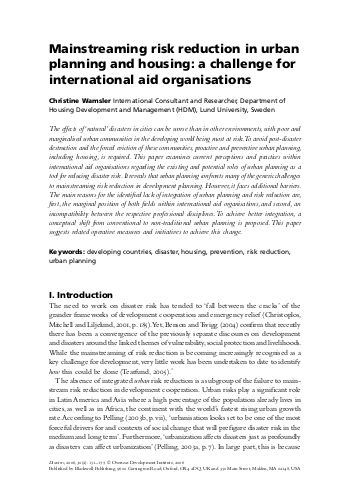
The effects of ‘natural’ disasters in cities can be worse than in other environments, with poor and marginalised urban communities in the developing world being most at risk. To avoid post-disaster destruction and the forced eviction of these communities, proactive and preventive urban planning, including housing, is required. This paper examines current perceptions and practices within international aid organisations regarding the existing and potential roles of urban planning as a tool for reducing disaster risk. It reveals that urban planning confronts many of the generic challenges to mainstreaming risk reduction in development planning. However, it faces additional barriers. The main reasons for the identified lack of integration of urban planning and risk reduction are, first, the marginal position of both fields within international aid organisations, and second, an incompatibility between the respective professional disciplines. To achieve better integration, a conceptual shift from conventional to non-traditional urban planning is proposed. This paper suggests related operative measures and initiatives to achieve this change.
Links
Resource collections
- UN Habitat - Urban Response Collection
- Urban Response - Urban Crisis Preparedness and Risk Reduction
- Urban Response Collection - Community Engagement and Social Cohesion
- Urban Response Collection - Economic Recovery
- Urban Response Collection - Environment and Climate Change
- Urban Response Collection - Housing, Land and Property
- Urban Response Collection - Urban Crisis Response, Recovery and Reconstruction
- Urban Response Collection - Urban Resilience